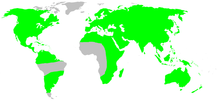Sac spider
 From Wikipedia - Reading time: 8 min
From Wikipedia - Reading time: 8 min
| Sac spiders Temporal range:
| |
|---|---|

| |
| Clubiona trivialis | |
| Scientific classification | |
| Domain: | Eukaryota |
| Kingdom: | Animalia |
| Phylum: | Arthropoda |
| Subphylum: | Chelicerata |
| Class: | Arachnida |
| Order: | Araneae |
| Infraorder: | Araneomorphae |
| Family: | Clubionidae Simon, 1878 |
| Diversity | |
| 18 genera, 665 species | |

| |
The sac spiders of the family Clubionidae[a] are nocturnal, sac-building hunting spiders with a near-worldwide distribution. Their sacs, silken retreats in which they hide during the day, are commonly spun between leafs, under bark, below rocks, or on plant terminals.[citation needed]
Although formerly a much larger catch-all taxon, in its current definition the family contains less than 700 described species across 18 genera, of which Clubiona is by far most species-rich, with 528 accepted species As of November 2024[update].[1]
Taxonomy
[edit]The Clubionidae have a complex taxonomic history. Historically, the family was a large catch-all taxon for a variety of spiders that shared the following morphological and behavioral similarities: having eight eyes arranged in two rows; having conical anterior spinnerets that touched; and being nocturnal wandering predators that build "sacs" to retreat to during the day.[citation needed]
A large number of genera have been transferred from Clubionidae to other families, and several former subfamilies of the Clubionidae are now treated as separate families.[2] The Zoropsidae, to which genera Anachemmis, Lauricius and Liocranoides were transferred, is much more closely related to the lynx spiders of family Oxyopidae than to the remaining Clubionidae.[3]
According to 2023 cladistic research by Siddharth Kulkarni, Hannah M. Wood and Gustavo Hormiga, the remaining Clubionidae remain polyphyletic as a result of the current placement of genus Elaver.[3]
Genera
[edit]As of November 2024[update], the Clubionidae consist of over 665 species in 18 genera worldwide,[4] with by far the majority of species in genus Clubiona. The following genera are accepted by the World Spider Catalog:[5]
- Arabellata Baert, Versteirt & Jocqué, 2010 — New Guinea
- Bucliona Benoit, 1977 — St. Helena, Kenya, Russian Far East, Korea, Japan, China, Taiwan
- Clubiona Latreille, 1804 — Africa, North America, Asia, Oceania, South America, Europe, Panama
- Clubionina Berland, 1947 — St. Paul Is.
- Elaver O. Pickard-Cambridge, 1898 — North America, Caribbean, Central America, South America, Philippines
- Femorbiona Yu & Li, 2021 — China, Vietnam
- Invexillata Versteirt, Baert & Jocqué, 2010 — New Guinea
- Malamatidia Deeleman-Reinhold, 2001 — Indonesia, Laos, Malaysia
- Matidia Thorell, 1878 — Asia, Papua New Guinea
- Nusatidia Deeleman-Reinhold, 2001 — Asia
- Porrhoclubiona Lohmander, 1944 — Asia, Africa, Europe
- Pristidia Deeleman-Reinhold, 2001 — Indonesia, Thailand, Malaysia
- Pteroneta Deeleman-Reinhold, 2001 — Asia, Australia
- Ramosatidia Yu & Li, 2021 — China
- Scopalio Deeleman-Reinhold, 2001 — Indonesia
- Simalio Simon, 1897 — Asia, Trinidad
- Sinostidia Yu & Li, 2021 — China
- Tixcocoba Gertsch, 1977 — Mexico
Additionally, the World Spider Catalog considers Carteroniella Strand, 1907 to be a nomen dubium.[6]
See also
[edit]Notes
[edit]- ^ the term "sac spider" is also part of the common name of various non-clubionid spiders, e.g. yellow sac spiders (Cheiracanthiidae) or corinnid sac spiders (Corinnidae)
References
[edit]- ^ "Clubiona Species list". World Spider Catalog Version 25.5. Natural History Museum Bern. Retrieved 26 November 2024.
- ^ "Clubionidae Simon, 1878". World Spider Catalog Version 25.5. Natural History Museum Bern. 2024. Retrieved 26 November 2024.
- ^ a b Kulkarni, Siddharth; Wood, Hannah M.; Hormiga, Gustavo (December 2023). "Advances in the reconstruction of the spider tree of life: A roadmap for spider systematics and comparative studies". Cladistics. 39 (6). doi:10.1111/cla.12557. ISSN 0748-3007. Retrieved 26 November 2024.
- ^ "Clubionidae Simon, 1878 - Family Detail". World Spider Catalog Version 25.5. Natural History Museum Bern. Retrieved 26 November 2024.
- ^ "Clubionidae Simon, 1878 - Genus List". World Spider Catalog Version 25.5. Natural History Museum Bern. 2024. Retrieved 26 November 2024.
- ^ "Carteroniella Strand 1907". World Spider Catalog version 25.5. Natural History Museum Bern. Retrieved 26 November 2024.
 KSF
KSF